There’s something oddly exciting about the first time you tow with a new truck. It’s where expectations meet reality, and where spec sheets either prove themselves or fall short. Whether you're pulling a small trailer or something heavier, it's in these moments you start to understand what your truck is really made of.
That’s why a post I came across today in the “2023–2025 Toyota Tundra Owners” Facebook group stood out to me. It was from Craig Craft, who had just taken his 2025 Toyota Tundra Limited out for its first towing run after coming from a 2012 Sequoia Platinum. Craig had just taken his 2025 Tundra Limited out for its first towing run after coming from a 2012 Sequoia Platinum, and he shared some initial thoughts on how the truck performed. While he appreciated the Tundra’s solid feel and newer features, he was surprised to find that his old Sequoia’s 5.7L V8 seemed to edge out the new truck in towing fuel economy. Here’s how Craig put it:
“First time pulling, coming from a 2012 Sequoia Plat to 2025 Tundra Limited, some pros and cons, but Tundra felt solid, 5.7 gas mileage pulling better for sure.”
That short comment packed a lot of insight for anyone who’s considering moving from an older Toyota to a newer Tundra, especially with towing in mind. It brings to light a conversation many Toyota owners are having: does the latest generation of Toyota’s full-size truck really deliver a better towing experience across the board, or are there trade-offs to be aware of?

What Other Owners Are Saying
Craig’s post opened the door to an honest look at real-world performance, and several other owners chimed in to share their thoughts. Mark P King jumped in to say, “Congrats on the upgrade. That is a big jump from a 2012 Sequoia Platinum to the 2025 Tundra Limited. I get what you are saying about the pros and cons. The Tundra feels more stable when towing. That updated frame and suspension really makes a difference. The old 5.7 had solid low-end pull, and yeah, gas mileage was better while towing, but overall the new setup gives you better control and a smoother ride. Once you get a feel for the power band and the tech features, I think you will really settle in. What are you pulling and how did it handle on inclines or in crosswinds?”
Craig responded with a bit more context: “Small 4400 dry weight trailer, no hills, and no crosswinds yet.” His comment, though brief, paints a picture of a light but realistic towing situation, showing that even without extreme load or weather conditions, certain differences between the trucks are noticeable.
Houston Lee added an observation about the Tundra’s suspension setup, asking, “Does yours have the auto leveling suspension? You don’t look to be squatting much for not having a WDH on it.” That small detail can speak volumes about the Tundra’s suspension geometry and balance when under load, something that’s particularly valuable to owners who want to tow without needing a full weight distribution hitch setup.
Geoff Mannix also brought his long-haul experience into the mix, saying, “I just got back from a 2500 mile trip to the Florida Keys with mine. I’ve done the trip twice since buying the truck and I definitely recommend a set of Timbren bump stops for the rear. The tundra is capable as is, but the ride is much better when loaded with the Timbrens and you won’t notice them when unloaded.”
This kind of feedback is gold for Tundra owners who plan to tow frequently. Timbren bump stops are one of those subtle modifications that don’t scream for attention but dramatically improve how the truck handles loads. It's the kind of upgrade you appreciate more with every mile, especially when you’re far from home cruising down unfamiliar highways. Mods like that make a difference without compromising everyday drivability.
Why Real-World Experience Still Matters
Reading through these comments, it becomes clear that while the 2025 Tundra is capable and the driving experience varies depending on what you’re towing, how the truck is set up, and what you’re used to. Some owners, like Craig, come from platforms like the 5.7L Sequoia that had brute low-end torque and a reputation for consistent towing MPG. Others are stepping into the newer world of turbocharged V6s, hybrid systems, and high-tech driving aids that offer different strengths. These offer better ride quality, quieter cabs, and smarter load handling.
This comparison reminds me of several similar stories I've covered, like when one driver admitted that after just 1,000 miles in a Toyota Tundra TRD Pro, they finally understood the love for it. These transitions are rarely cut-and-dry as they’re layered with personal expectations, brand loyalty, and real-life demands. In fact, another owner even shared that they held onto their 2007 Toyota Tundra for 276,000 miles until the 2025 finally won them over.
The Changing Landscape of Modern Trucks
And honestly, this is part of what makes modern truck ownership so complex and fascinating. The latest generation of Tundras might surprise long-time owners in both good and unexpected ways. Just ask the owner who lifted their 2024 Toyota Tundra and was surprised by the results, it's a perfect example of how modern setups can defy expectations. Some are discovering that switching from American trucks to Toyota changed everything they thought they knew.
From my perspective after following these ownership stories, I think it’s important to zoom out and realize that technology brings trade-offs. You might gain smoother ride dynamics and advanced towing tech but lose the raw mechanical feel and simplicity of a naturally aspirated V8. The Tundra Limited is undeniably more refined, and for many, that refinement is worth the price of admission.
But for those who were expecting a night-and-day difference, especially in MPG while towing, reality might not match the marketing. In some cases, owners have experienced more dramatic changes, like the one who found out their 2023 Tundra needed a new engine during a routine oil change. The comparison might feel closer than expected or even lean in favor of the older truck in some ways. What I appreciate about posts like Craig’s is that they keep the conversation grounded in reality and not just specs or hype, but how the truck feels on the road doing real work.
Key Takeaways for Readers:
- Learning curve: If you’re upgrading from a Sequoia or older Tundra, expect a learning curve in how the new Tundra manages power and fuel under load as it’s not always a clear step forward.
- Ride quality mods: Suspension upgrades like Timbrens can offer major improvements in ride quality without affecting unloaded comfort.
- Fuel economy reality: Real-world fuel economy while towing may not always improve with newer tech, sometimes the tried-and-true V8 just delivers better in certain conditions.
- Community insight: The collective experience from Facebook groups and forums often reveals truths that spec sheets never will.
What Do You Think?
What’s one mod or setup change you’ve made that completely transformed your towing experience?
And if you have a Tundra, how’s your towing going so far? What’s the MPG looking like? Is it really a dealbreaker for you?
We’d love to hear what worked and what didn’t in the comments section below.
Aram Krajekian is a young automotive journalist bringing a fresh perspective to his coverage of the evolving automotive landscape. Follow Aram on X and LinkedIn for daily news coverage about cars.
Image Sources: Toyota Gallery and the "2023-2025 Toyota Tundra Owners" public Facebook group.


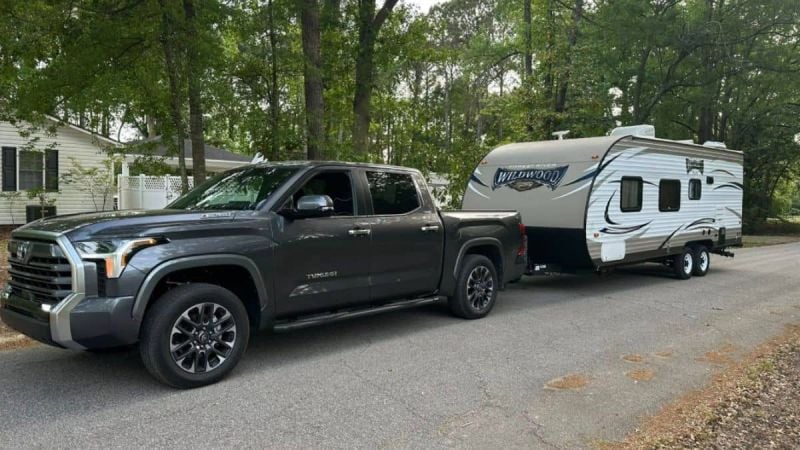




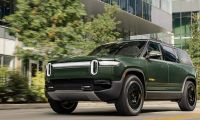
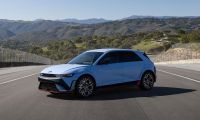
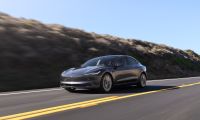

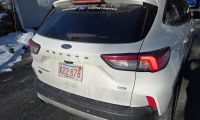
Comments
Is this just an AI summary…
Permalink
Is this just an AI summary of a forum chat?
Let's face it. When It comes…
Permalink
Let's face it. When It comes to Real Truck stuff toyota never even enters the conversation. And obviously Sales prove it year after year.....
I have a 2022 Tundra Limited…
Permalink
I have a 2022 Tundra Limited and don't need bump stops when towing my 9000LB travel trailer. The difference might be in that I'm using a weight distribution hitch.
One thing I want to mention is the power when pulling is amazing. Heck, I've even passed slow drivers with ease on 2 lane back country highways. Going over mountain passes, not an issue, this truck is a beast.
I do want to share that the wind noise is terrible at highway speed. A lot of folks online complain about this.
That’s awesome to hear that…
Permalink
In reply to I have a 2022 Tundra Limited… by DavidS (not verified)
That’s awesome to hear that your setup handles the trailer so well David.
Those weight distribution hitches really make a difference. I’ve heard the same about wind noise too, it’s something Toyota hopefully improves in future updates.
Something is fishy about…
Permalink
Something seems fishy about this guy’s experience. I’ve owned a 2000, 2008, 2014, and now a 2022 SR5 with the 8-foot bed. At best, under ideal speed and conditions, I get around 23 mpg — typically it’s closer to 17 mpg. I also regularly tow a 20' x 104" deckover flatbed trailer that weighs about 3,300 lbs, and even then I usually see around 16 mpg. When fully loaded and towing just over 10,000 lbs, I’m seeing about 12 mpg.
I live in Colorado, so the driving conditions vary from flat highways to mountainous roads. The truck definitely gets better mileage if you use mid-grade gas instead of 85 octane in the V8. Comparing it to my old '14 Tundra, which averaged 15 mpg and dropped to 8 mpg when towing under the same conditions, it’s honestly pretty comparable. One costs less at the pump but requires more fill-ups; the other costs more per gallon but gets slightly better mileage. Is it worth it? I still ask myself that question every day.
If he’s really getting that kind of mpg out of his '25, I’d sell it in a heartbeat. For reference, I’ve had zero issues with any of my Tundras.
Appreciate you laying out…
Permalink
In reply to Something is fishy about… by Steve s (not verified)
Appreciate you laying out your real-world numbers for us Steve.
That’s a solid breakdown. MPG always varies with terrain, load, and fuel type, so I get the skepticism. If your 2022 is running strong and consistent, that’s a win in itself!
The biggest difference Craig…
Permalink
The biggest difference Craig is going to feel in his towing experience is when he uses a good quality weight distributing hitch. Just because the truck looks to have minimal squat while hooked up is only one small part of the equation. Toyota has installed active front air dams on most of their new generation Tundras that deploy as you get to higher speeds to improve fuel economy but hooking up a trailer deactivates it so any extra lift on the front end will be very detrimental to fuel mileage. A good weight distributing hitch properly set up will get your rig level as it should be. And shifting more weight to the front of the truck will also improve its ride. Safety should be top priority when towing and not having any sway control while towing that much weight is hazardous. Maintaining proper control of your unit in an emergency situation, crosswinds or being passed by transports is what a well made weight distributing hitch is designed to do. There are jurisdictions where they are required although no such federal law exists. The accepted standard is if your trailer exceeds half the weight of your tow vehicle then a weight distributing hitch should be used. It is also recommended in the Tundra owners manual. Craig's trailer is 4400 lbs, his truck is at most 6095 lbs. While fuel economy is a concern it pales in comparison to others when towing that much weight.
Great points all around…
Permalink
In reply to The biggest difference Craig… by Steve (not verified)
Great points all around Steve.
And it lines up with what the previous commenter mentioned too about using a weight distribution hitch. It really does more than just level things out visually as it improves safety, ride quality, and even fuel efficiency in real-world towing. Makes a strong case for investing in the right gear.
Interesting. My 2021 F150 2…
Permalink
Interesting. My 2021 F150 2.7 is the best towing vehicle I've had. Past trucks were a F150 5.0, and a Ram 1500 Hemi, all pulling the same travel trailer at about 5000lb. The little 2.7 is amazing. Through the Canadian Rockies it never struggles and I've never come close to needing full throttle. It's dead quiet and gets the best towing mileage of the three, not to mention an unloaded range of 1300km without refueling. I would have thought the new Tundra with turbo enhanced low rim torque would have been better than the V8.
I have to call BS on this,i…
Permalink
I have to call BS on this,i had an 07 Tundra with the 5.7 and it was diabolical on gas when towing. My 23 Tundra gets way better mileage, the only.thing I can think happened is they didn't use the towing modes.
I just report the news Huw!…
Permalink
In reply to I have to call BS on this,i… by Huw Howells (not verified)
I just report the news Huw!
But no I totally get what you mean haha. On first thought it definitely doesn't seem right, but his experience could be a result of certain different conditions.
I replaced my 2016 3/4 ton 4…
Permalink
I replaced my 2016 3/4 ton 4 x4 RAM 6.4L hemi with a new 2023 Tundra Hybrid. It literally blows the doors off the RAM while towing. Mountains, interstate highway,all of it. More power, and yes better fuel mileage. I'm loving it!!!!
That’s awesome to hear Steve…
Permalink
In reply to I replaced my 2016 3/4 ton 4… by Steve Brown (not verified)
That’s awesome to hear Steve.
Sounds like the hybrid Tundra was a serious upgrade for you! Getting more power and better mileage is a win-win, especially when towing through tough terrain. Wish you many happy miles!
Just bought a 25. Have a 32'…
Permalink
Just bought a 25. Have a 32' 9000 lb trailer. I'm worried about performance. Although rated at 13,000 lb.
Still kept my dodge 2500 5.9 diesel just in case. I have a concern with performance and towabiliy. The ride of the dodge just get to me unloaded on rough roads/streets.
Understandable concern…
Permalink
In reply to Just bought a 25. Have a 32'… by MICHAEL (not verified)
Understandable concern Michael.
Get back to us and let us know how the Tundra performs. And who knows, if you find some interesting results, get back to me on X and we can get your story out here on Torque News if you're interested. I'm always looking for more owner experiences!